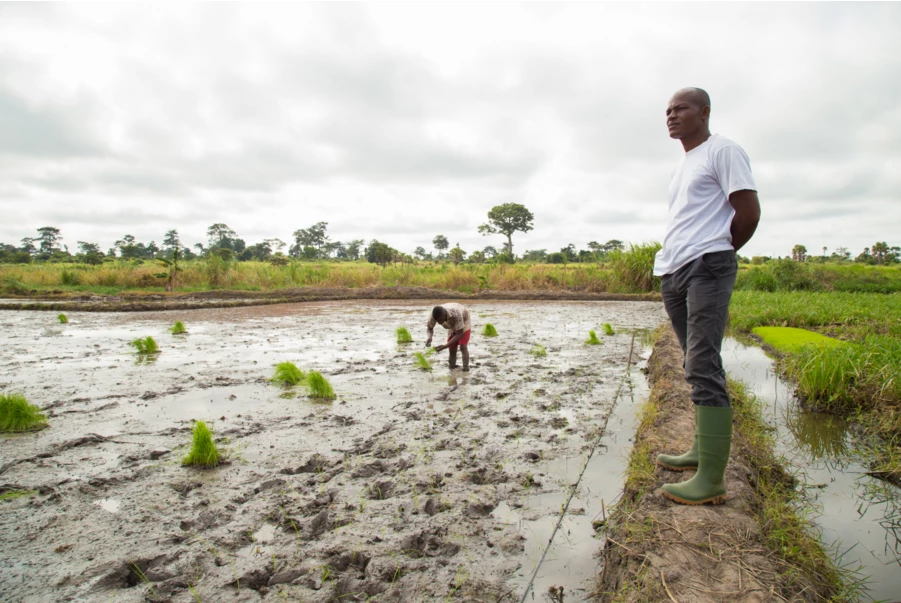Also available in: Spanish - French - Arabic

Here’s something you may not be aware of: agriculture and changes in land use already contribute 25 percent of greenhouse gas emissions. It’s a statistic that matters in the face of two unrelenting challenges now facing the globe –how to turn the promises of last December’s historic Paris climate change agreement into reality and how to feed a growing global population.
Already more than one billion people on the planet are now undernourished , and the world needs to produce at least 50 percent more food by 2050 to feed an estimated nine billion people. And we have to achieve that while delivering on the Paris agreement to keep the global temperature rise well below two degrees Celsius and to drive efforts to limit the temperature increase even further to 1.5 degrees Celsius above pre-industrial levels.
On a continent like Africa, we already know climate change is taking a toll on farmers seeking to feed their families and earn some income. Just consider West Africa, where shorter and more erratic rainy seasons and more frequent extreme weather events such as droughts and floods have impacted harvests. And according to projections, climate change could cut yields even more – by as much as 25 percent in the future.
To help them adapt to the changing climate, farmers in West Africa have been learning the benefits of “climate-smart agriculture” – an integrated approach that helps farmers grow more, be more resilient to climate change and reduce greenhouse gas emissions from livestock, crops, and land use change.
Through the World Bank funded West Africa Agricultural Productivity Program (WAAPP) close to six million farmers have learned how to become “climate smart” through using 160 climate-smart crop varieties developed through the program – a move which has seen productivity boosted by at least 30 percent.
With Bank support , 1.7 million dairy farming households across 18 Indian states are adopting better feeding and fodder practices for their cows. Use of local and seasonal green fodder and grain has boosted milk yields, reduced production costs and decreased methane emissions by about 12 percent while increasing net daily incomes by nearly 25 rupees per cow.
Farmers who have adopted agroforestry are reaping bountiful harvests without the use of costly fertilizers—like in Zambia, where maize planted under Faidherbia trees have yielded harvests that are three times larger than usual. In Senegal, a lack of rainfall during the planting season led to withered crops and low yields, obliging farmers to reseed in an effort to recover their losses. An emergency program under WAAPP is providing one-time subsidies on the sale of almost 2,000 tons of certified maize, millet, and sorghum seeds. The improved seeds result in crops that have shorter maturity cycles and are more drought resistant, resulting in higher yields.
And in Asia, alternate wetting and drying rice production techniques in Vietnam helped more than 33,000 farmers boost crop production by up to 10 percent. They achieved this jump in productivity while using less fertilizer, which has reduced methane and nitrous oxide emissions from their rice fields.
We know there’s also growing recognition of the role of agriculture in the overall mix of emissions which we need to bring down globally to achieve the global targets set in Paris. At COP 21, 113 countries committed to reduce agriculture sector emissions as part of their Intended Nationally Determined Contributions (INDCs) or domestic climate action plans.
While globally governments, scientists and farmers are taking steps to make a sustainable, climate-smart global food system a reality, more needs to be done.
We know for the world’s poorest countries, especially those funded by IDA, our fund for the poorest, climate-smart agriculture is vitally needed to help farmers grow more and reduce post-harvest losses so there’s more food in the face of a changing climate.
Across Africa, most of the national climate plans, the INDCs, prepared for Paris prioritize adaptation. For example, Niger’s INDC included sustainable land and forest management and climate smart agriculture with a strong emphasis on food security, farms and pastoralist communities.
It’s also singled out in both the World Bank’s Africa Climate Business Plan, unveiled in Paris, and also our Climate Action Plan, developed post-Paris to lay out a roadmap to help countries deliver on their promises in Paris.
And we’re already acting. Earlier this year, the Bank approved the Niger Climate-Smart Agriculture Support project , which is the first Bank project in Africa specifically designed to deliver climate-smart agriculture, as laid out in our Africa Climate Business Plan. The project will directly benefit around 500,000 farmers and agro-pastoralists in 44 communes. This was a big step. Our hope is that this project will pave the way for a more climate-smart food system in Niger, as well as in other countries, funded by IDA.
For our part, we have made climate smart agriculture a key component in all our operations. Last year, 50 percent of the Bank’s agricultural projects delivered all three of the aims of climate-smart agriculture – increasing productivity, boosting resilience and delivering a lower carbon footprint. Benefits include lowering aquatic nitrogen pollution and biodiversity impacts.
We know the path to climate-smart agriculture will be different in every country and is made even more challenging by limited resources. This is why the Bank has developed tools and analytical work to help countries assess opportunities, balance trade-offs, prioritize investments and identify key entry points for climate-smart agriculture.
Transitioning to a climate-smart food system is no longer just the ambition of a few. But still, we need greater ambition. Our ability to feed the world’s future population depends on us all becoming climate smart.



Join the Conversation